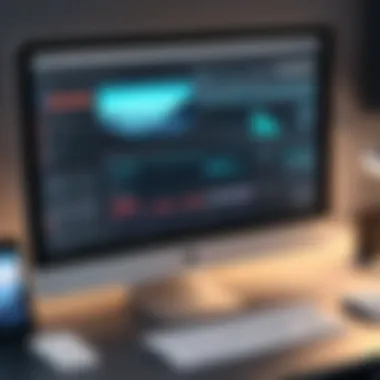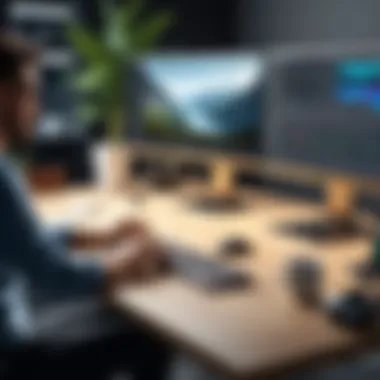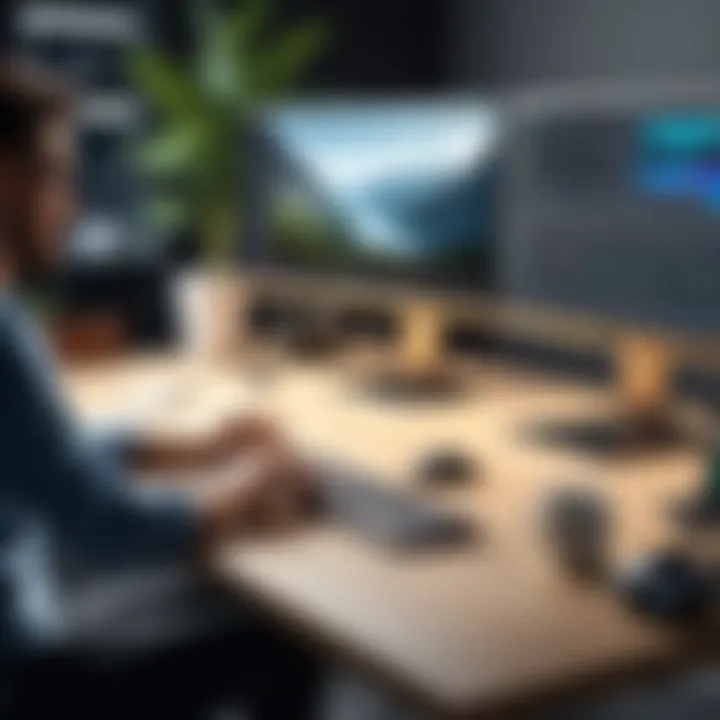Exploring the Full Potential of Screenshot Editors


Intro
In today’s fast-paced digital landscape, the ability to capture and manipulate information instantly has taken on monumental importance. This is where screenshot editors come into play, serving a vital role in helping users snatch snippets and enhance their productivity. These tools are not merely about what you can see on the screen; they open up a world of opportunities for organization, creativity, and communication.
With the swirl of continuous information at our fingertips, having the right tools to manage that data effectively can be a game changer. Let’s pull back the curtain on the technology underpinning these handy software solutions and see how they can fit into your daily routine, whether for professional endeavors or personal projects.
Overview of the Technology
Key specifications
Screenshot editors generally come packed with a variety of features. Here are some typical specifications you might find in a high-quality editor:
- Capture Modes: Options that allow full-screen captures, window-specific shots, or selected area snapshots.
- Annotation Tools: Brushes, arrows, and text boxes that let you add commentary or highlight parts of the image.
- Editing Capabilities: Minimal adjustments like cropping, resizing, or adjusting brightness directly within the tool.
- File Formats: Export options that include popular formats such as PNG, JPG, and even GIFs for animated captures.
These specifications not only define a spaghetti of capabilities, they also underscore the endless possibilities for users.
Unique selling points
What sets apart powerful screenshot editors from their more mundane counterparts? Consider the following:
- Integration with Other Tools: Many screenshot editors can seamlessly connect with productivity apps, streamlining your workflow.
- Cloud Sharing Options: Instantly share your edits through cloud services or social media platforms, fostering collaboration or further distributing your content.
- User-Friendly Interfaces: A clean and intuitive design, making it easy even for non-techies to navigate the tool effortlessly.
The idea is to deliver a robust product that caters to varying levels of comfort with digital tools, ensuring everyone can utilize its potential.
Design and Build Quality
Material used
Most screenshot editor applications, especially desktop versions, prioritize streamlined coding over flashy interfaces. However, some invest time in creating aesthetically pleasing layouts that make interaction more enjoyable. The materials, so to speak, are not limited to physical components but focus on how software is structured and navigated.
Ergonomics and usability
While the design may vary, usability usually remains king. Systems that allow keyboard shortcuts for faster access can make a world of difference. Imagine needing to capture an important moment; the last thing you want is to fumble around in menus. An ergonomic approach includes considering how users think and act, shaping the program to fit their needs rather than the other way around.
"The best tools are those that slip into the workflow, almost unnoticed, functioning as an extension of your own capabilities rather than an add-on that complicates your tasks."
Real-World Applications
Understanding the functionality provides little value unless you can connect it with real-world application. Professionals in fields like design, marketing, and education find ample benefits from screenshot editors. For instance, a designer can convey edits on mockups with precise annotations, ensuring that the vision carries through all stakeholders. Meanwhile, educators can utilize screenshots for presentations, enhancing student engagement by creating interactive learning moments.
As we dive deeper into the functionalities and the best options available, we'll explore how each tool contributes to optimizing diverse workflows and elevating digital interactions.
Stay tuned as we move forward and discuss various tools, compare their strengths, and understand how to select the most aligned options for your specific needs.
Understanding Screenshot Editors
Screenshot editors are tools that go beyond the basic capture functionalities, providing users with a comprehensive suite of features to manipulate, enhance, and share screenshots effectively. In today’s fast-paced digital world, where communication is often visual, the importance of these tools cannot be understated. Whether for educational purposes, report generation, or daily tasks, having the right screenshot editor can streamline workflow, improve clarity and ensure that information is conveyed accurately.
The ability to capture an image of what is displayed on a screen may seem simple, yet the nuances involved in screenshot editing can vastly differ based on the tool employed. Users need to consider various factors like usability, available features, and integration capabilities when determining which screenshot editor suits their requirements best. As the need for visual communication has surged, understanding how these tools function can transform the way one approaches tasks that depend on visual presentations.
Defining Screenshot Editors
Screenshot editors are software applications designed to capture what is currently displayed on a screen and allow for post-capture editing. This editing can encompass a variety of functions including cropping, annotating, and applying effects to the captured image. The main objective of these editors is to enhance the user's ability to communicate visually. Essential features often include the ability to add text, shapes, and even emojis, as well as providing tools for blurring sensitive information or highlighting important areas within the image.
For instance, when working on a project where feedback is vital, a screenshot editor can allow team members to pinpoint issues directly on visual materials, fostering a clearer discussion without the need for extensive written explanations. In essence, screenshot editors act as bridges that connect complex visual data with user-friendly workflow enhancements.
Historical Development of Screenshot Tools
The journey of screenshot tools has evolved significantly over the years, from simple captures to sophisticated editing environments. In the early days of computing, taking a screenshot was often a cumbersome process requiring keyboard shortcuts that were not intuitive. Tools were limited and often required additional software to edit the images after capturing them. However, as technology progressed, developers recognized the need for more user-friendly interfaces and feature-rich options.
By the late 1990s and early 2000s, dedicated screenshot tools began to emerge, allowing users not only to capture images but also to quickly annotate them. This period saw the launch of Windows' built-in Snipping Tool, which became a staple for many users.
In recent times, the advancement of cloud technology and mobile devices has spurred on further innovations. Now, user can find a plethora of options ranging from specialized software like Snagit to extensions and apps available for smartphones. The blending of standalone applications with cloud services allows for seamless sharing and collaboration, significantly enhancing the functionality users expect from screenshot editors today.
As it stands, the landscape of screenshot tools continues to adapt and grow, driven by the changing nature of how people communicate and share information in both personal and professional settings.
Key Features of Screenshot Editors
Understanding the key features of screenshot editors is vital for anyone looking to enhance their digital productivity. These tools aren't just about taking pictures of your screen; they come packed with functionalities that can help you communicate ideas clearly, preserve information, and save time. When users choose the right editor, they can significantly streamline their workflow, especially in professional settings where visual communication is crucial.
Basic Editing Functions
To start with, let’s look at the basic editing functions, which are the bread and butter of any screenshot editor. These features allow users to make quick adjustments right after capturing an image.


Cropping Images
Cropping images is a fundamental function of screenshot editors. The essence of cropping lies in allowing users to focus on the most important part of the screenshot, eliminating any unwanted background distractions. This feature is essential because it enhances clarity, making messages easier to convey.
The key characteristic of cropping is its simplicity. Users can easily adjust the frame to highlight specific areas, making it a popular choice for a variety of tasks, from creating tutorial materials to preparing presentations. A noteworthy aspect of cropping is its ability to maintain the resolution quality of the edited portion, which is a great asset when precision is necessary. However, one downside is that inexperienced users may inadvertently remove important context if they are not careful in their selection.
Adding Text
Adding text to screenshots serves as a powerful way to annotate information, provide context, or even add humor to a visual. This function is particularly valuable when you need to clarify a point for viewers or coworkers.
The great thing about adding text is that it’s customizable—different fonts, colors, and sizes can be used to fit the tone of the message you want to convey. Moreover, the capability to place text anywhere on the image makes it adaptable for various scenarios. Still, one must be cautious not to clutter the image with excessive text, as that could detract from the overall effectiveness of the message.
Annotation Tools
Annotation tools elevate the process of screenshot editing. They allow users to draw, underline, or create shapes on the image, adding another layer of communication. This utilization is especially beneficial in team collaborations where feedback needs to be visually communicated.
The key feature of annotation tools is versatility. Users can express detailed thoughts clearly through arrows and shapes, guiding attention precisely where it’s needed. However, a potential drawback lies in the user’s ability—those unfamiliar with such tools might struggle, leading to annotations that lack clarity.
Advanced Editing Capabilities
Once the basics are out of the way, advanced editing capabilities step in to offer more nuanced control over the edited images.
Blurring Sensitive Information
Blurring sensitive information is critical in our increasingly digital world. This feature allows users to obscure data such as email addresses, phone numbers, or financial information before sharing images. The importance of this cannot be overstated.
A striking aspect of blurring is its effectiveness—it can immediately transform sensitive content into something safe for public view. Despite this benefit, blurring can sometimes lead to ambiguity if not applied carefully, as users might misinterpret the blurred content.
Image Filters and Effects
Image filters and effects are less common in screenshot editors, but they add a unique dimension to your visuals. Filtering options can enhance or alter colors, and give images a professional finish that can impress viewers.
The primary characteristic of filters is customization; they can provide a personal touch or fit a specific branding requirement. On the flip side, an overuse of effects can make the image less genuine, causing viewers to become skeptical about the content that is presented.
Collaborative Features
In today’s interconnected workplace, collaborative features are increasingly indispensable. These capabilities foster teamwork by allowing multiple users to edit and comment on a single screenshot in real-time. This can greatly enhance communication and the speed of project completion.
Collaboration tools’ primary focus is on streamlining group efforts, which is a major plus for teams working remotely or cross-functionally. However, these features often require a stable internet connection, and if not users may face synchronization issues.
The comprehensive functionality of these features illustrates their importance. By choosing a screenshot editor that encompasses these capabilities, users can significantly enhance their editing processes, allowing for greater efficiency and creativity in their tasks.
Popular Screenshot Editor Tools
When it comes to capturing and editing screenshots, choosing the right tool can make all the difference. Popular screenshot editor tools offer a variety of functions that cater to both novice users and seasoned professionals, each bringing their own unique features to the table. This section will shed light on notable free and premium software options, assessing how they can enhance productivity and streamline workflows.
Free Tools Overview
Lightshot
Lightshot remains a standout in the realm of free screenshot tools. Known for its simple and intuitive interface, it allows users to select any area of their screen for immediate capture. One key characteristic of Lightshot is its speed; users can snap screenshots and edit them almost in real-time. This efficiency makes it a popular choice among those who need quick and effective screen capture capabilities.
A unique feature of Lightshot is its cloud-sharing functionality. Once a screenshot is taken, it can be uploaded to the cloud instantly, enabling easy sharing via a link. However, a potential disadvantage is the lack of advanced editing options compared to some premium tools. Despite this, Lightshot's user-friendly design and effective immediacy make it a must-have for casual users.
Snipping Tool
Another widely used option is the Snipping Tool, which has been a part of Windows OS for quite some time. This tool offers a lightweight solution for users looking to capture snippets of their screen without extensive editing features. The Snipping Tool’s strength lies in its accessibility; it is readily available on almost all Windows devices without requiring any additional downloads.
Its key characteristic is the variety of snip options like rectangular, free-form, window, and full-screen snips. However, a notable downside might be its limited capabilities for further editing. Users often find themselves needing supplemental software for annotation, which can detract from its overall efficiency. Still, for users who just need a quick snippet, the Snipping Tool is highly beneficial.
Greenshot
Greenshot is another free tool that has gained popularity for its balance of simplicity and functionality. It captures screenshots efficiently and provides a range of editing tools to annotate or highlight elements directly. The standout aspect of Greenshot is its integration with various platforms like Microsoft Office, making it a great asset for those in professional settings.
Moreover, one unique feature Greenshot boasts is its ability to quickly export captured images to different destinations, such as printers, email, or cloud services. This versatility is often seen as a significant advantage compared to other free tools. However, one might argue that it doesn’t have as user-friendly an interface as Lightshot, which could pose challenges for individuals unfamiliar with screen capturing.
Premium Software Alternatives
While free tools often meet basic needs, premium software options provide advanced functionalities that can significantly enhance the user experience.
Snagit
Snagit is arguably one of the most renowned premium screenshot editors in the market. What sets Snagit apart is its comprehensive toolset that goes beyond just capturing images. It facilitates video recording, providing a versatile environment for users. This aspect makes it especially appealing for professionals who need to create tutorials or presentations.
One of Snagit’s unique features is the ability to create custom templates for consistent branding in captured content. However, this level of sophistication comes at a cost, and for individuals or businesses on a budget, it might be considered a bit pricey. Despite the investment required, the benefits of extensive capabilities generally outweigh the costs for dedicated users.


PicPick
PicPick is another premium option that combines a screenshot capture tool with graphic design features. With its user-friendly interface, PicPick caters to both novice and experienced users. Its standout characteristic is a built-in image editor, allowing users to enhance their screenshots without needing to switch to another program.
One unique feature PicPick offers is a color picker, which is especially useful for designers and developers needing accurate color codes. However, it might be a bit bloated for users who only need very basic functionality. Overall, PicPick provides an excellent balance of simplicity and advanced features.
Skitch
Skitch, which is part of the Evernote family, specializes in enhancing visual communication. The tool allows users to quickly annotate images with arrows, shapes, and text. Its key feature lies in the ease of use, making it popular among teams that require clear and quick communications through visuals.
One advantage of Skitch is its close integration with Evernote, allowing seamless transitions between note-taking and visual edits. However, some users have pointed out that its features can feel somewhat limited compared to heavier editing software, but for those heavily invested in the Evernote ecosystem, it’s a natural fit.
The right screenshot tool can not only boost productivity but also improve how we communicate ideas and information visually.
Choosing the Right Screenshot Editor
Selecting the right screenshot editor can feel like trying to find a needle in a haystack due to the plethora of options available. Not all screenshot editors are made equal, and choosing the most suitable one can significantly enhance productivity whether for personal or professional use. Each user has unique needs, and it is crucial to evaluate which features align best with individual or organizational goals. This section delves into essential aspects to consider when making this important decision.
Assessing User Needs
Personal vs. Professional Use
When deciding on a screenshot editor, it’s essential to consider whether the tool will serve personal or professional needs. Personal users might prioritize elegance and ease of use, while professionals often require robust features that facilitate better communication and collaboration.
A key characteristic of personal use is the focus on simplicity. Users may opt for tools that allow quick captures with minimal fuss. Conversely, professional use emphasizes advanced functions including annotation, editing, and integration with other software.
For instance, tools that allow better organization of screenshots, such as tagging and folders, can be beneficial in professional settings. However, they may be unnecessary for casual use, turning routine tasks into a chore rather than a breeze. Hence, understanding the context of use helps in narrowing down options effectively.
Feature Prioritization
Once user needs are established, the next step is to prioritize features that matter most. This means deciding whether image filters, collaboration options, or ease of sharing hold more weight in the decision process.
The unique aspect here is the varied expectations depending on the type of user. A budding photographer might be drawn to features that allow image enhancements, while a workplace team member might prioritize real-time collaboration options.
For example, if the editing capacity is essential, a user might look for tools like Snagit or PicPick that offer rich feature sets suitable for more complex editing requirements. In contrast, someone seeking a quick screen capture may benefit from the straightforward functionality of Lightshot. Thus, effective feature prioritization ensures that users do not end up bogged down with unnecessary tools.
Budget Considerations
Free vs. Paid Solutions
The financial aspect is often a big part of the decision-making process. There are numerous free solutions available that deliver essential functionalities, like the Snipping Tool or Greenshot. However, these tools may have limitations in terms of advanced features.
The main advantage of free solutions lies in their accessibility, making them appealing, especially to students or hobbyists. Yet, there could be drawbacks such as lacking customer support, ad interruptions, or fewer updates. Paid solutions often come with robust support and continual enhancements, which might justify the initial investment for users who require more dependable functionality for their workflow.
Value for Money
When evaluating expenditures, value for money becomes a significant consideration. This concept is about assessing whether the features and support offered justify the cost of the software. A screenshot editor with a higher price tag might provide valuable features that could save time or improve quality in the long run.
For instance, software like Snagit might seem pricey compared to free alternatives, but the advanced editing capabilities and seamless integration with other apps can actually enhance workflow efficiency significantly.
Thus, when weighing features against cost, one might determine that though some tools may require upfront investment, their long-term contributions to productivity provide excellent value for money.
"Choosing the right tool is not just about picking the latest or most expensive option, but finding a solution that fits your needs and assists you in reaching your goals."
Integration with Other Tools
In today’s fast-paced digital landscape, screenshot editors have become essential tools not just for capturing images, but also for seamlessly integrating into broader workflows. The ability to blend these editors with other software solutions maximizes efficiency and enhances productivity across various projects. This section delves into how screenshot editors work well with different tools, focusing on project management software and cloud services.
Working with Project Management Software
Project management software such as Trello, Asana, or Jira serves as a digital hub for collaboration and task organization. Integrating screenshot editors into these platforms streamlines communication among teams. For instance, instead of laboring over lengthy email explanations, users can quickly capture a screenshot, annotate it, and share it instantly. This visual feedback can often convey complex ideas far more effectively than text alone. When deadlines loom, this rapid exchange of information is invaluable.
Moreover, many of these editors allow for direct uploads to project management tools. For example, if someone is using Snagit, it supports exporting files directly into Trello cards or Asana tasks. This integration eliminates the clunky steps of saving files locally before uploading, allowing teams to stay agile. Additionally, the use of tagging and labeling within these platforms can be enhanced by the visual content captured, leading to clearer and better-organized insights.
Compatibility with Cloud Services
Cloud services, like Google Drive or Dropbox, have revolutionized file storage and sharing, making it simpler to access information from anywhere. When screenshot editors are compatible with these services, users gain the benefit of cloud integration. With a cloud-linked screenshot tool, any visual content captured can automatically save in designated folders, ensuring that crucial data is readily accessible across devices without the extra hassle.
Furthermore, collaborative features These benefits are especially significant in environments where teams work remotely. For example, using a screenshot editor like Lightshot allows users to easily share links to the screenshots directly from its interface to a team member’s Google Drive. This means that your colleague can view or edit the material on-the-fly without having to wait for emails or file transfers.
"The synergetic relationship between screenshot tools and cloud services effectively removes barriers to sharing, which is vital for modern teamwork."
By utilizing integration with cloud services, you can also rest assured that your annotations or edits are automatically saved and backed-up. This compatibility fits well within any digital workflow, especially in a world that increasingly prioritizes remote collaboration and real-time access to shared resources.
Through strategic integrations with project management software and cloud services, screenshot editors not only simplify the process of capturing images but also enhance the overall productivity of team-oriented tasks and personal projects. The result is a cohesive approach to managing information that aligns perfectly with the demands of a tech-savvy work environment.


The Role of Screenshot Editors in Education
In today's fast-paced educational landscape, screenshot editors have emerged as invaluable tools. Their functionality goes beyond mere image capture, serving as catalysts for enhanced learning experiences. This section delves into how screenshot editors play a pivotal role in education, particularly in facilitating online learning and enhancing study materials.
Facilitating Online Learning
Screenshot editors have become essential in the rise of online education. With platforms like Zoom or Google Meet dominating the remote learning scene, the ability to share and manipulate visual information has never been more crucial. Educators often find themselves using these tools to capture important discussion points, diagrams, and visual aids during lectures.
Imagine a teacher explaining a complex mathematical concept. Instead of relying solely on verbal explanations, they can capture a screenshot of a detailed graph or math problem and instantly annotate it. This allows students to grasp the material more effectively, complementing auditory and visual methods of instruction.
The advantages don't stop there. Screenshot editors also foster greater collaboration among students. Group projects often require sharing of ideas and resources. By using screenshot functionality, students can capture and annotate relevant sections of their textbooks or online resources, facilitating clearer discussions. They can create step-by-step processes for problem-solving or document the evolution of their projects visually, making learning interactive and engaging.
Enhancing Study Materials
In the realm of study materials, screenshot editors offer a wealth of opportunities to improve the quality and effectiveness of resources. Students can take snippets of textbooks, lectures, or online articles, allowing them to personalize their study decks. Every student has their unique method of learning, and screenshot tools can help tailor materials to suit individual needs. For instance, a student studying biology might capture crucial diagrams and label them according to their understanding. This method reinforces memory and aids retention significantly.
Moreover, educators can create comprehensive study guides using screenshots. By collating various screenshots into one document, they can provide a richer learning experience that aligns with curriculum goals. This kind of resource becomes particularly handy before exams, as students benefit from having all key information accessible in a single glance.
To summarize, screenshot editors are not just supplementary tools; they embody the dual role of enhancing both teaching and learning. As educational methodologies evolve—rapidly shifting to embrace digital learning—these editors stand out, optimizing the way knowledge is absorbed and shared.
"In the information age, the ability to tailor and curate learning materials is fundamental to student success. Screenshot editors make this a tangible reality."
For educators and students alike, the integration of screenshot editing technology represents a significant step forward in educational practices that embrace clarity, interactivity, and personalization. It contributes to a profound learning culture that recognizes and adapts to the diverse needs of learners.
Best Practices for Utilizing Screenshot Editors
In the fast-paced realm of digital communication, knowing how to effectively use screenshot editors can significantly streamline your workflow and sharpen your presentation skills. Understanding best practices in this area is not just a trivial add-on; it's about harnessing the full potential of your tools. Properly utilizing screenshot editors can save time, ensure clarity, and add professionalism, whether you’re creating content for a client, sharing information with a colleague, or crafting educational materials.
Effective Annotation Techniques
When it comes to annotating screenshots, the goal is clarity and usefulness. Annotations should guide the viewer’s understanding without overwhelming them. Here are some techniques to keep in mind:
- Be Concise: Use short, direct words. Long descriptions can cause a reader to lose focus. For example, instead of saying "To initiate the download, ensure you check the box for agreement," simply highlight the box and label it as "Check This!"
- Highlight Key Areas: Don't just annotate everywhere; focus on what absolutely needs emphasis. Use arrows, circles, or boxes to draw attention. This helps in making critical details pop out—like knowing where to click on a crowded interface.
- Color Psychology: Choose colors mindfully. For instance, red might signify a warning, while green could indicate correct actions. This subtle unspoken language assists in quicker comprehension.
- Use Legends: When employing various symbols or colors, a small legend can do wonders. It anchors the reader and reduces confusion.
"A picture is worth a thousand words, but a well-annotated screenshot speaks volumes."
Avoiding Common Mistakes
While learning the ropes, it's easy to stumble upon pitfalls that can hinder your message. Awareness of these common faults can keep your screenshots effective:
- Neglecting Quality: Blurred or pixelated images lower professionalism. Always ensure clarity by using high-resolution screenshots. If necessary, utilize image optimization tools to maintain quality, especially when sharing online.
- Overloading Information: It's tempting to include everything but resist this urge. Too many annotations can make a screenshot look cluttered. Focus on the essentials that will guide the viewer without overwhelming them.
- Ignoring Consistency: Your annotation style should remain consistent throughout your materials. If you favor a specific font, color, or arrow style, stick to it. Consistency helps in easy navigation and recognition.
- Failing to Test: Don’t assume everyone will understand your annotations as you do. Test your screenshots with someone who's not familiar with the topic. Their feedback can highlight areas for improvement you may not see.
By keeping these best practices in mind and incorporating effective annotation techniques, you’ll enhance your screenshot editing skills significantly. Whether for work, education, or casual sharing, mastering the art of screenshot annotation can make your content far more impactful.
Future Trends in Screenshot Editing
The world of screenshot editing is evolving at an astonishing pace, much like technology itself. As we embrace change, staying current with future trends can be the difference between an average editing experience and one that seamlessly integrates into our digital workflows. This section focuses on two significant aspects: the incorporation of artificial intelligence and the emergence of new technologies that will shape how we edit screenshots.
Incorporating Artificial Intelligence
Artificial intelligence is not just a buzzword; it’s becoming a crucial player in screenshot editing. The benefits of AI span multiple avenues. From automating routine tasks like cropping and resizing to providing intelligent suggestions for edits, AI saves both time and effort. Imagine editing a screenshot where the AI automatically highlights key elements, suggesting annotations based on the context of the image. Such advanced functionalities can make editing less tedious and more intuitive.
Consider the implications of AI-powered tools analyzing your editing habits. They can learn your preferences and customize the interface to suit your workflow better. For instance, tools could prioritize certain features based on usage patterns. This adaptability not only enhances user experience but can also lead to higher quality output because the tool aligns with individual artistic sensibilities.
Emerging Technologies Impacting Editing Tools
The landscape of editing tools is also being influenced by groundbreaking technologies. One noteworthy trend is the integration of augmented reality (AR). Imagine using a screenshot editor where you can interact with screenshots in a virtual environment, layering elements and visual annotations as if they’re right in front of you. AR could redefine how we engage with screenshots, blurring the line between digital and physical interactions.
Additionally, cloud-based editing solutions are gaining momentum. With the ever-increasing demand for remote collaboration, integrating screenshot editing with collaborative platforms makes perfect sense. Users can share, comment, and edit screenshots in real-time, irrespective of their locations. This cloud-centric approach not only enhances teamwork but also secures stored data, as it moves away from traditional, device-centric methods.
Looking ahead, as AI and emerging technologies blend with screenshot editors, we can anticipate a more personalized experience that adapts to our needs.
Epilogue
When looking back over the entire scope of screenshot editors, it’s clear that they play an invaluable role in the modern digital workspace and personal contexts alike. These tools have evolved from simple capture functionalities to robust platforms capable of enhancing communication, collaboration, and creativity. Their importance cannot be overstated; they offer not only basic features but also advanced editing capabilities that cater to varied user needs, from educators sharing resources to professionals creating presentations.
"Screenshot editors are not just tools; they are bridges that connect ideas with presentation."
Recap of Key Insights
To summarize, we delved into several critical aspects of screenshot editors:
- Defining Characteristics: We established an understanding of what constitutes a screenshot editor and how it has evolved over time.
- Essential Features: From cropping and annotating to advanced options like collaboration tools, these features empower users to convey information effectively.
- Market-Ready Tools: We reviewed both free and premium options, emphasizing the range available to cater to various budgets and needs.
- Application in Different Scenarios: Examining the contextual use within education and business settings highlighted their adaptability and essential nature.
- Best Practices: Adopting effective annotation techniques helps in maximizing the utility of these tools.
Yet the core takeaway remains: regardless of which tool one chooses, enhancing communication through visuals is a basic human need in today's online landscape.
Final Thoughts on Screenshot Editors
In a world where information travels at lightning speed, the tools we use to capture and present that information can drastically alter the clarity and effectiveness of our communication. Screenshot editors have become a pivotal part of our toolkits, seamlessly integrating into our workflows, whether for professional tasks or educational purposes.
While technology continues to evolve, the fundamental role of screenshot editors remains steadfast—they allow users to articulate ideas more clearly and share them more effectively. With emerging trends like AI integration and innovative editing features on the horizon, it's an exciting time to explore how these tools will grow and shape our interactions in the digital age. Investing time in choosing the right screenshot editor could mean the difference between a good presentation and an outstanding one. Therefore, embracing these tools with a keen sense of purpose can significantly elevate one’s productivity and communication acuity.







